Chapter 4
Taming the Savage Lands
(In this round, I'm positive I made a few mistakes. I took some short-term risks in getting Zululand settled and running for, I hope, long-term gain. I have a feeling a lot of you guys are going to be tearing your hair out about certain decisions, and of course I'm eager to see what you think I could've done better. But we came out strong and, I think, in a position to take the game in whatever direction we want.
Some adjusted micro and builds to start
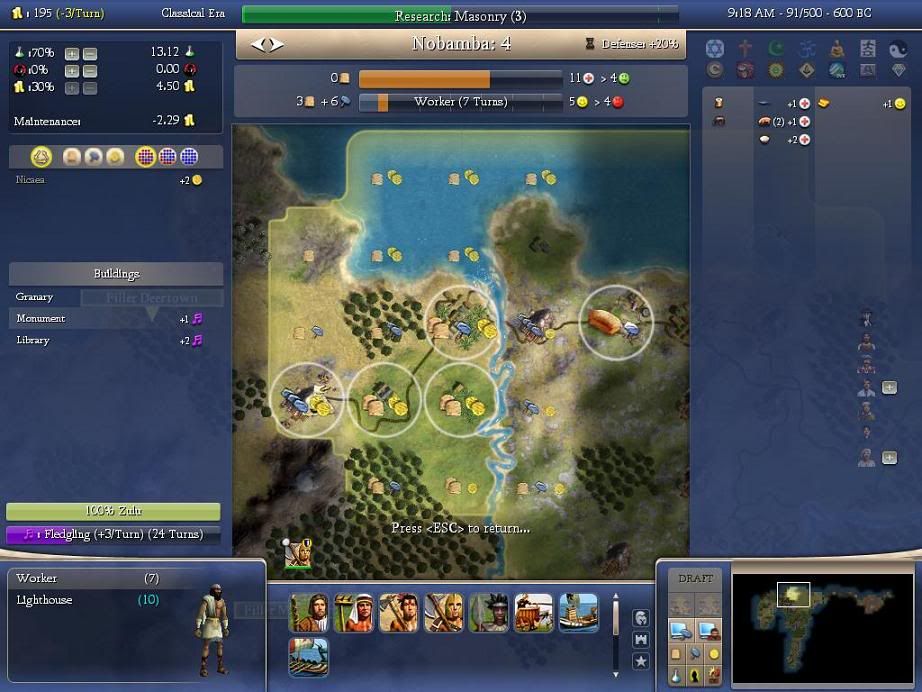 (uMtown started working that cottage near the pigs, and I made Bulawayo a worker pump for much of the round. I left the Lighthouse in the queue, figuring I'd get to it much later in the game and not wanting to waste any hammers. However, I took my eye off the ball and built it accidentally late in the round. Sort of an unfortunate loss of hammers, but eh, it is what it is.)
(uMtown started working that cottage near the pigs, and I made Bulawayo a worker pump for much of the round. I left the Lighthouse in the queue, figuring I'd get to it much later in the game and not wanting to waste any hammers. However, I took my eye off the ball and built it accidentally late in the round. Sort of an unfortunate loss of hammers, but eh, it is what it is.)
Shaka's lands were mighty, spanning from sea to shining sea, west to east. However, they were not enough. The Hindu holy lands to the east boasted opulence and piety, and the empires of Justinian and Isabella were impressive indeed. If Shaka was to gain their trust and gain allies as he cemented his hold on Zululand, his empire would have to match theirs... and even exceed it. Atop his Throne of Skulls, the war-chief vowed that the Barbarian lands would fall to him--peacefully or by the axe.
Shaka first sought to better understand the roots of the Hindu faith. Justinian--master of the written world--offered to help, as well as to grant Zululand access to the secrets of the Dutch spear-casters, which Shaka learned were called "archers."
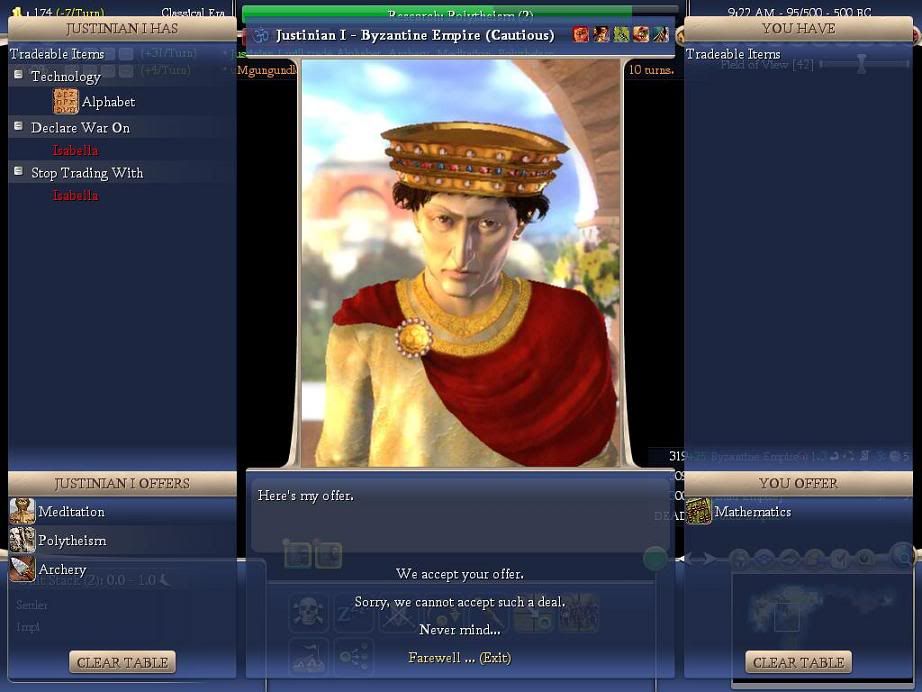 (Archery was a throw-in; obviously I did this for the religious tech. I'm not too fussed about giving Justin access to long division, especially with after shaving a few turns after Poly--turns that, as I think you'll see, we'd really want later on when things started going south. And, of course, this got Justin up to Pleased quickly.)
(Archery was a throw-in; obviously I did this for the religious tech. I'm not too fussed about giving Justin access to long division, especially with after shaving a few turns after Poly--turns that, as I think you'll see, we'd really want later on when things started going south. And, of course, this got Justin up to Pleased quickly.)
In 475 BC (
Why do we count backward on this foolish Hindu calendar? Shaka wondered.), the warrior-settlers (really a press gang of burly nobles with clubs) traveled to the west coast. The villagers of the tribe kwaDukuza--who thrived on fishes and cows--were the first to fall into line.
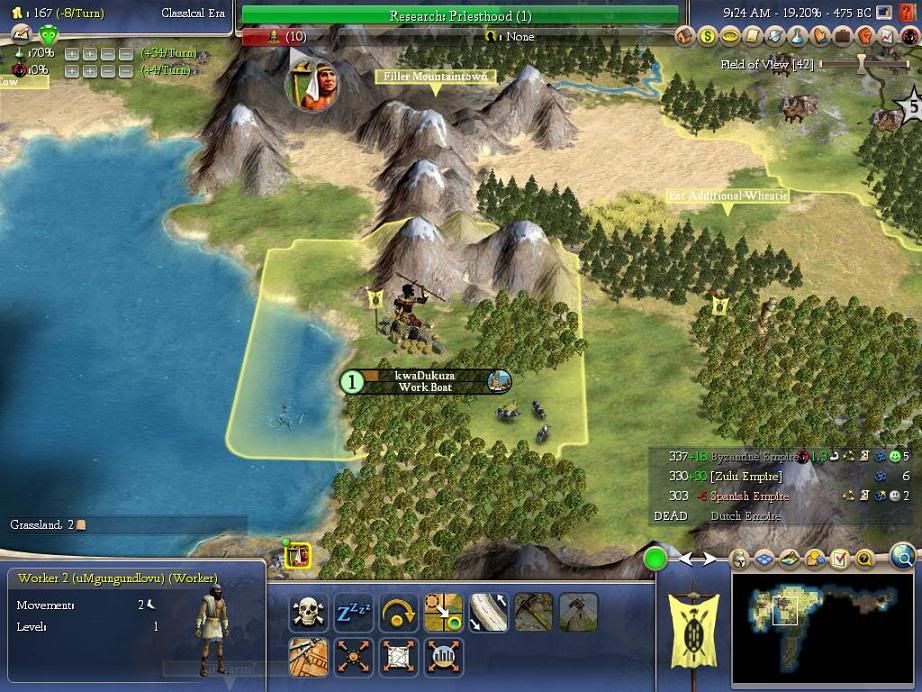
As Zululand continued to codify a priest caste
(an easy way to up our happy cap), the intrepid diplomatic fishing boat discovered an errant scout in Spain. The scout traveled to the Holy Mountain with his master, a bloodthirsty tyrant in a fashionable headdress. Shaka recognized him as a warrior-chief like himself, and the two took to each other like a Bulawayo resident to the whip. Shaka knew his Zulu people could gain much by befriending these bizarre people: the Aztecs.

The warriors who had taken Amsterdam continued to the north, finding nothing of note:
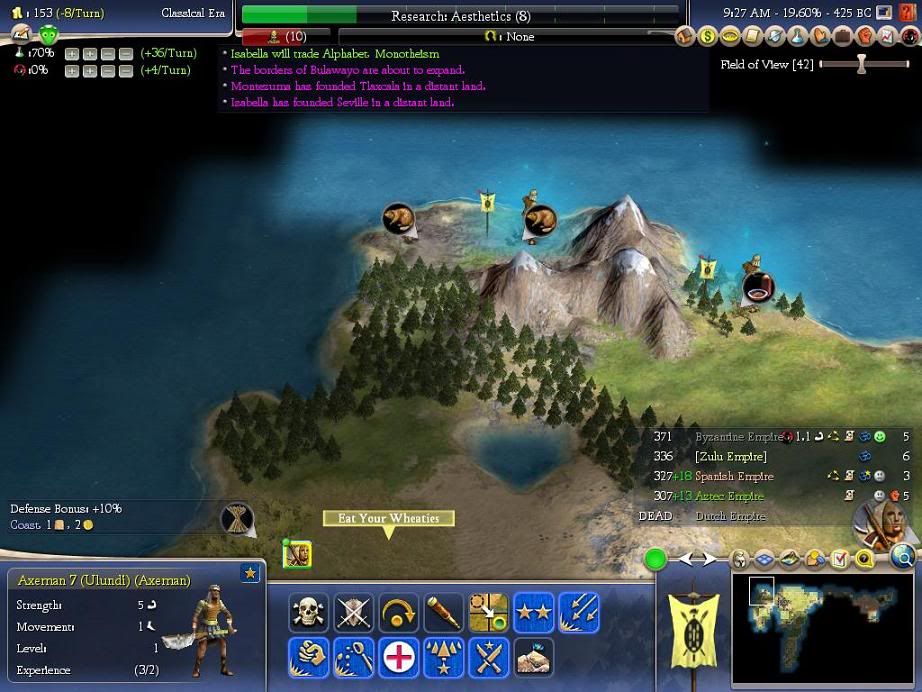
They were set as sentries at the borders of Amsterdam, guarding the city against Barbarian incursion.
Not much later, the Zulu alliance with the Aztecs was sanctified, and Montezuma himself joined the enlightened fold:
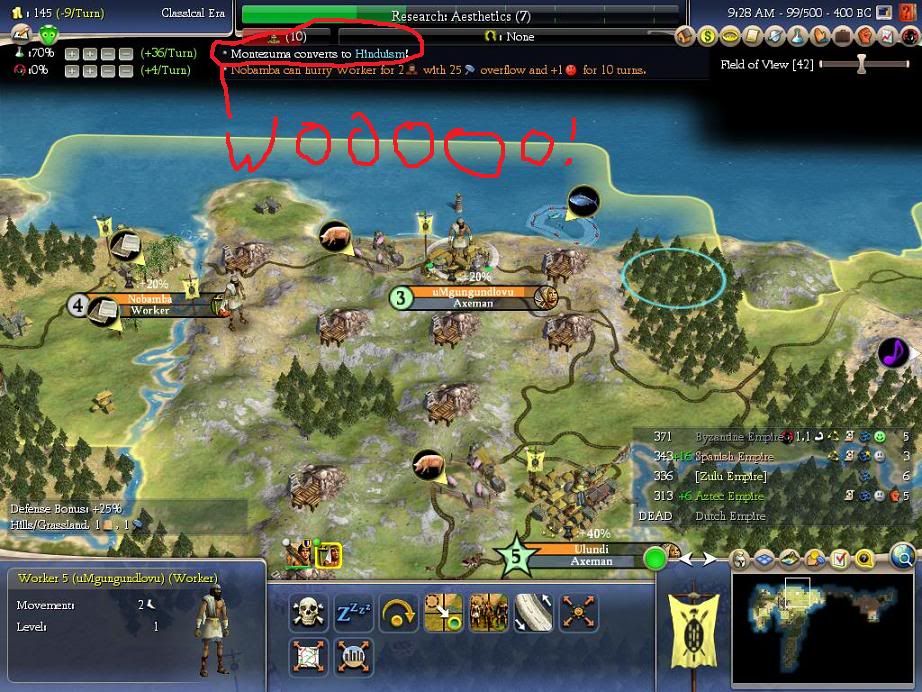 (YAAAAAAAAAAAAY! Having Monty with us means we don't have Monty against us, which will make diplomacy more of a breeze... as you will see.)
(YAAAAAAAAAAAAY! Having Monty with us means we don't have Monty against us, which will make diplomacy more of a breeze... as you will see.)
South of Spain, the diplomats' boat encountered a strange sight along the ocean: a high wall that stretched across the length of the southern border of Spain. The people on the other side of the wall were no Hindus; rather than taking to the idea of karmic justice, they walked a path of peace and meditation towards enlightenment. Their leader met the diplomats once, and the reports were sent back: this man was mad. Wearing an elaborate crown despite his people's ignorance of Monarchy, this chief was different from the late Willem. Willem was merely a poet/scholar; this man was a lunatic.
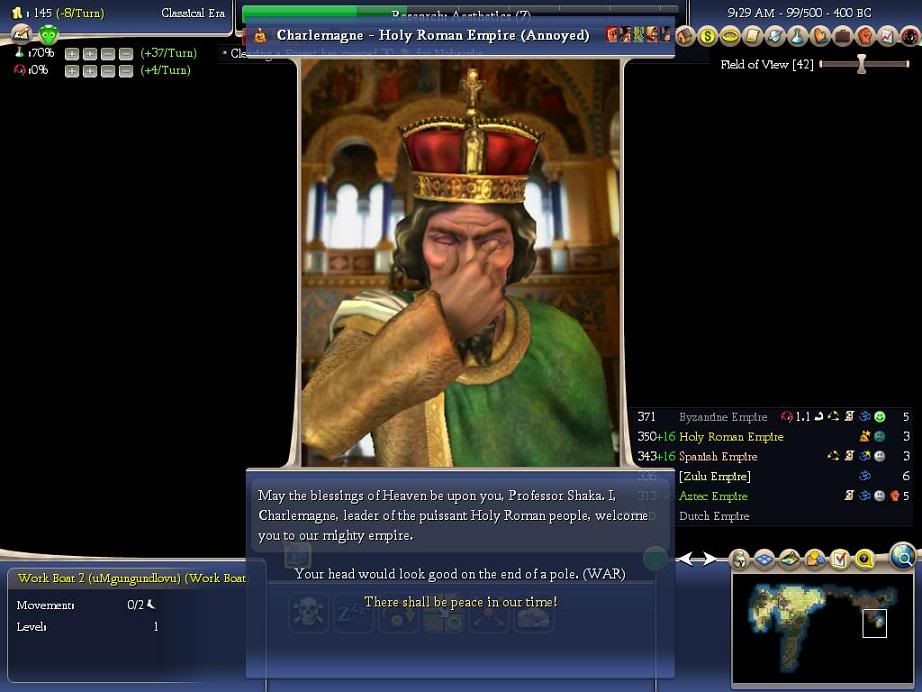
The diplomats, ignorant of Holy Roman pronunciation, instead took to calling this chief "Chuck." He did not take to it well.
(...well. I think we've found our future military conquest. And yes, ol' Chuck indeed built the Great Wall for us!)
Years later, the Hindu scholar Herodotus released his study of the nations of the world.
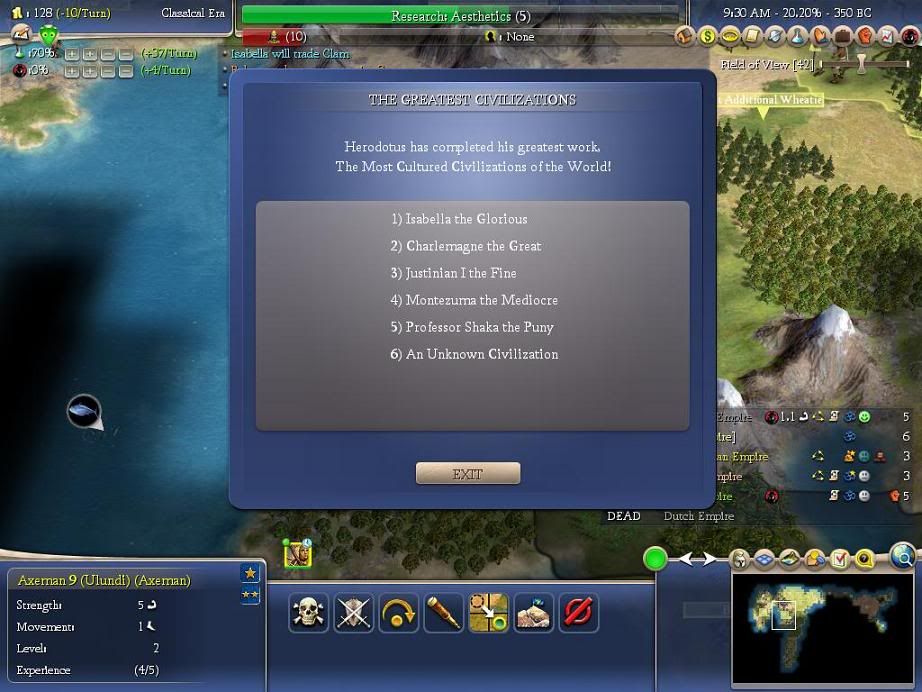
"Puny?" Shaka scoffed. "We will show this fool who is puny!"
Infuriated not by the substance of the report but by its undiplomatic use of adjectives, Shaka himself vented his rage by personally joining the incursion to the Barbarian lands:
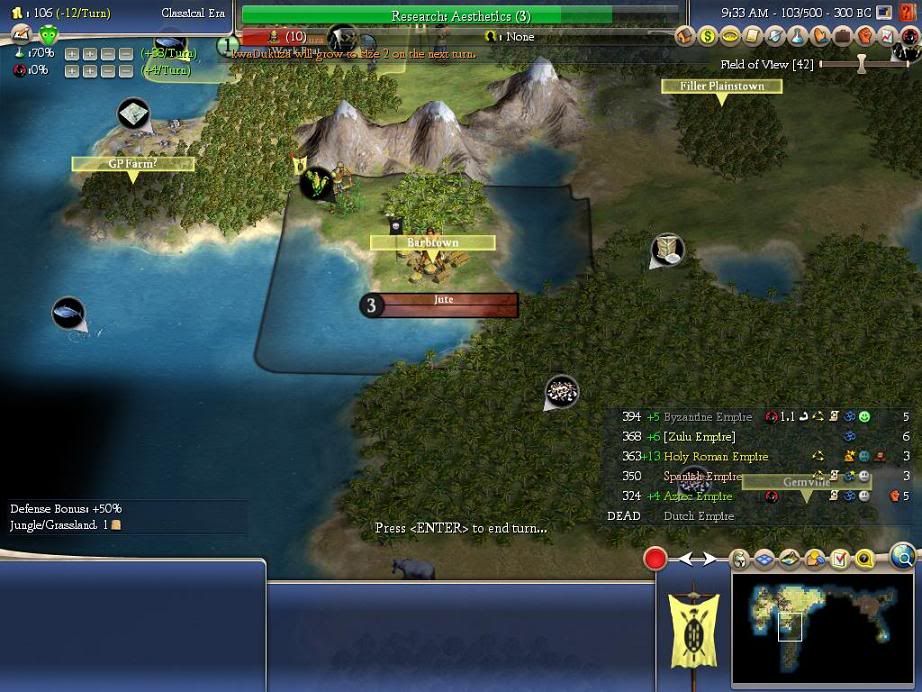
This tribe, called the Jute, fought well, but their pathetic clubs were no match for Zulu metallurgy. Unlike the previous tribes of this land, however, Shaka allowed this settlement to stand.
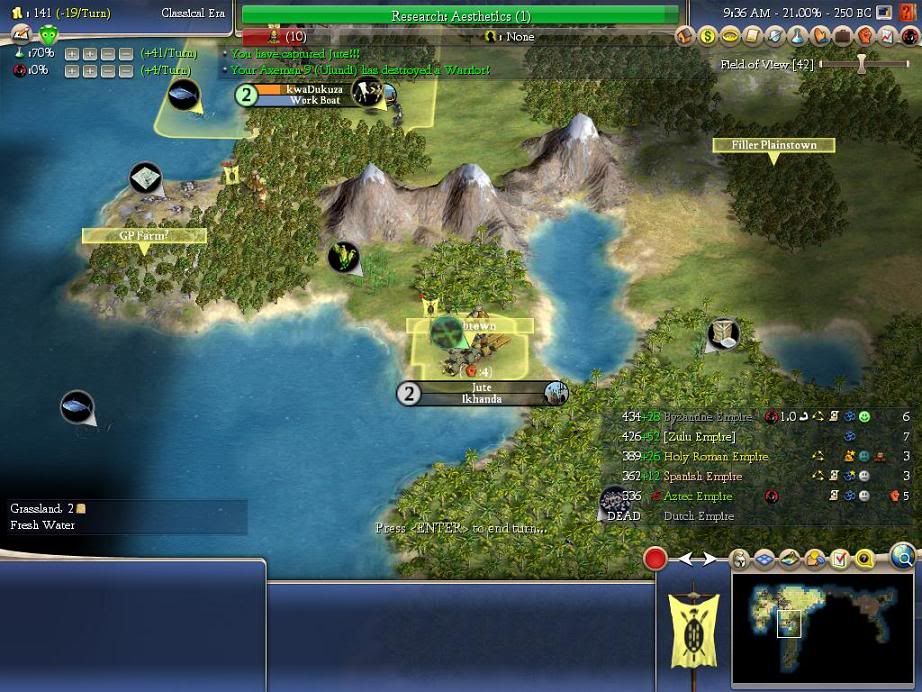 (No infrastructure inside, but it saved us a settler. As you'll see, though, I think keeping this site was a mistake; it ended up being a huge drag on the economy, which was already starting to tank.)
(No infrastructure inside, but it saved us a settler. As you'll see, though, I think keeping this site was a mistake; it ended up being a huge drag on the economy, which was already starting to tank.)
In just a few years' time, warrior-settlers from Ulundi had "settled" the cities of Ondini and Nongama
(Yeah, I forgot to take screenshots, but they weren't long after Jute was taken.). The people of Nongama were particularly important to Shaka's plans: the village promised access to beautiful Marble in its hills, a building material that Shaka's warrior-scholars insisted could be used to beautify his empire.
Shaka's main concern, however, was not his nobles' quest for beauty; rather, it was his own empire's hemorrhaging funds. The lands in the south had tremendous promise, but for now, they were a tremendous drag on Zulu finances. Shaka's warrior-accountants came to their chief with a proposal for action: a unified Currency, the first of its kind in this part of the world.
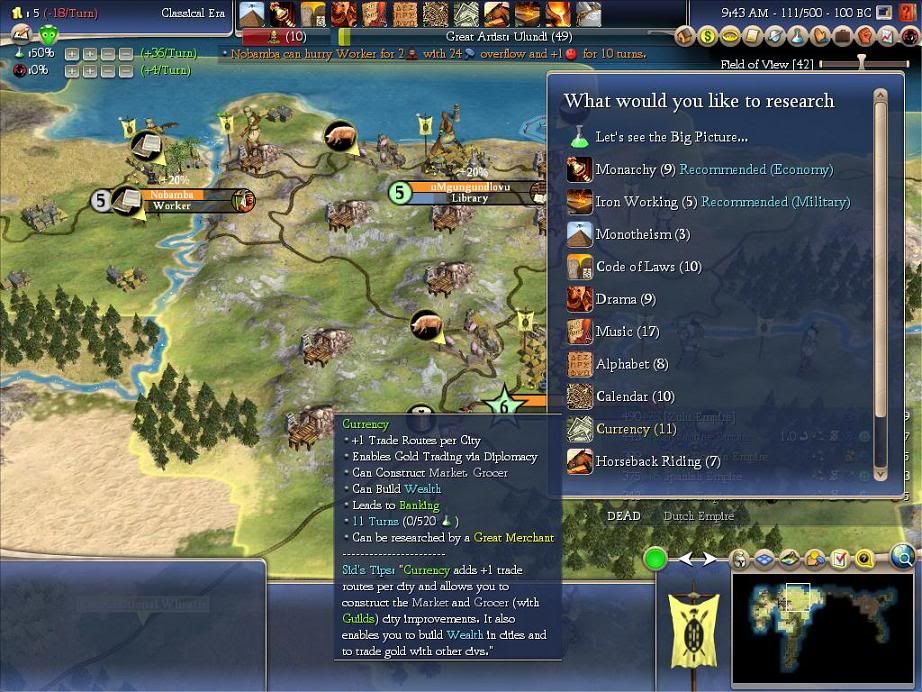
Shaka consented to this; he only hoped it was not too late to save his kingdom. He had been busy trying to make Zululand great not just in land, but in architecture. His warrior-artisans in Ulundi, enlightened by the knowledge of Aesthetics gained to satisfy the grumbling Dutch of the west, sought to build a massive statue of their chief that would intimidate all who would attack Zululand. However, in their ignorance, they accidentally gave their lord a beard and a toga:
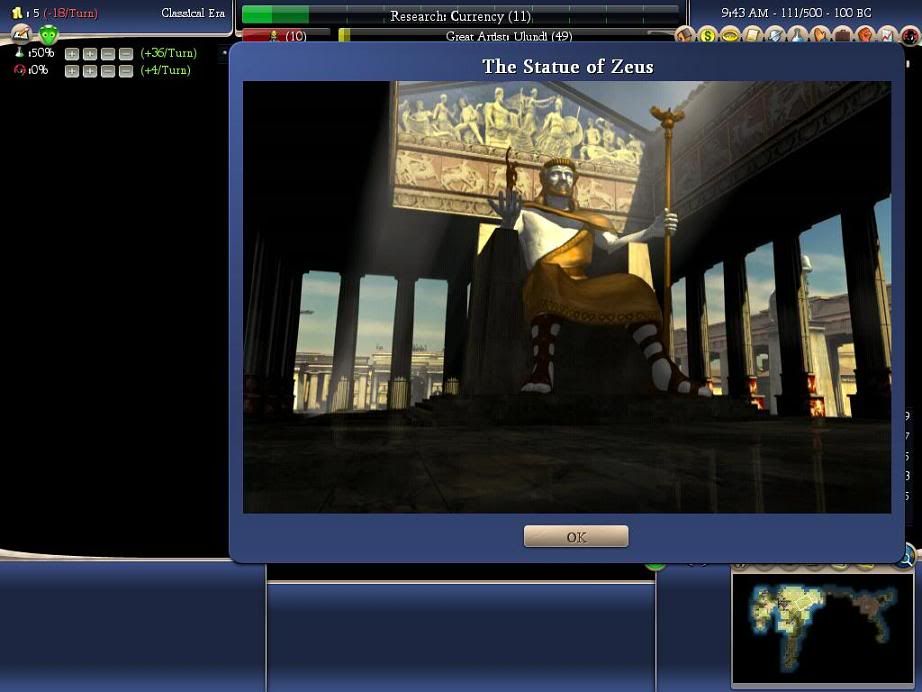
They were summarily executed. The statue, nevertheless, inspired awe from as far away as Holy Rome, where "Chuck" was said to be mortified at the implications of its presence.
(Hey, we had Ivory, and it was a pretty cheap build. We're basically denying it to the AI--I don't anticipate anyone being able to reach us to field a credible military threat, but it would su-hu-huck for Chuck to build it when he's clearly our next target.)
With the secrets of Aesthetics having served its primary purpose, Shaka traded its secrets to Spain for access to advanced metal-working and a more codified practice of the faith.
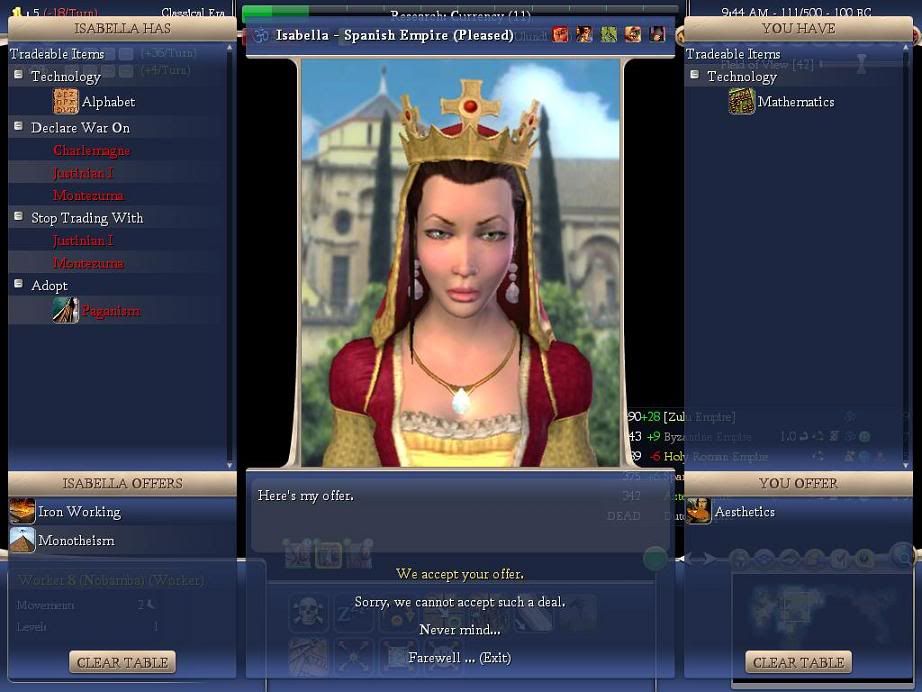 (We didn't adopt OR just yet; the trade was to get IW PDQ [OMG BBQ]. We didn't need a high upkeep civic like that when we were already bleeding funds, but the backfill was nice.)
(We didn't adopt OR just yet; the trade was to get IW PDQ [OMG BBQ]. We didn't need a high upkeep civic like that when we were already bleeding funds, but the backfill was nice.)
Shaka, knowing how his people had been fortunate to acquire Copper so close to home, doubted that this new metal--"Iron"--would be found within his own lands. However, the gods had blessed the war-chief once again:
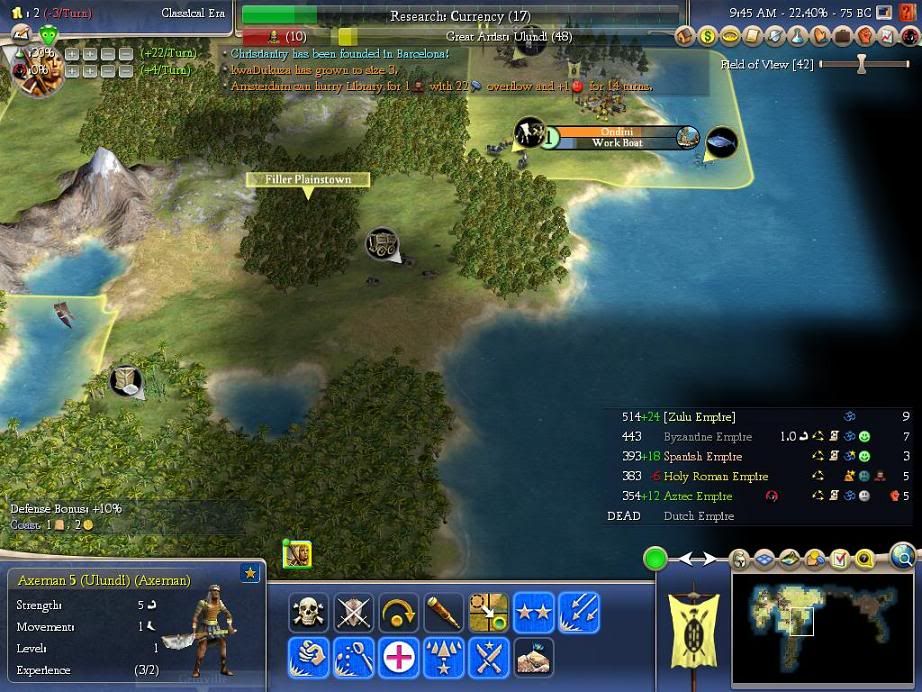
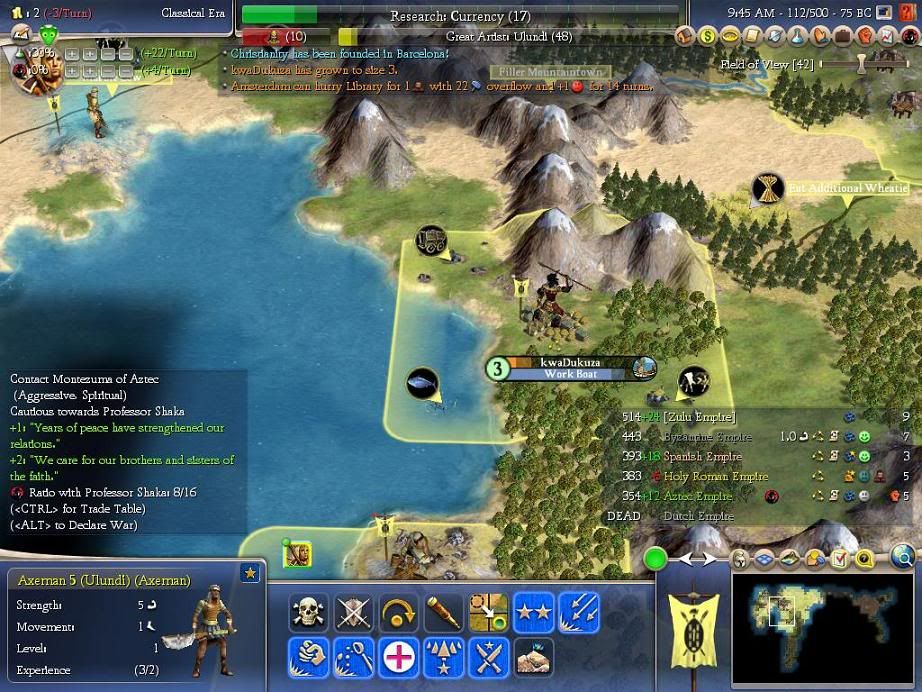
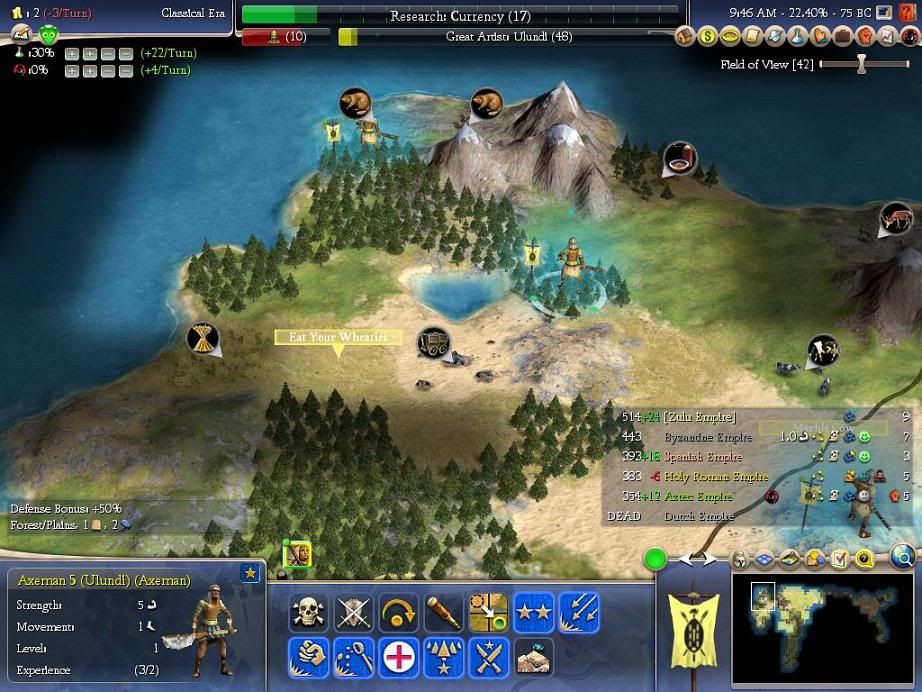 (...well.
(...well.  This certainly makes the filler plains town more of a monster.)
This certainly makes the filler plains town more of a monster.)
With the economy in tatters thanks to Shaka's attempts to settle as much as possible, the war-chief sought what technologies he could find anywhere. The Spanish and Byzantines, however, proved to be no friends when Shaka was down.
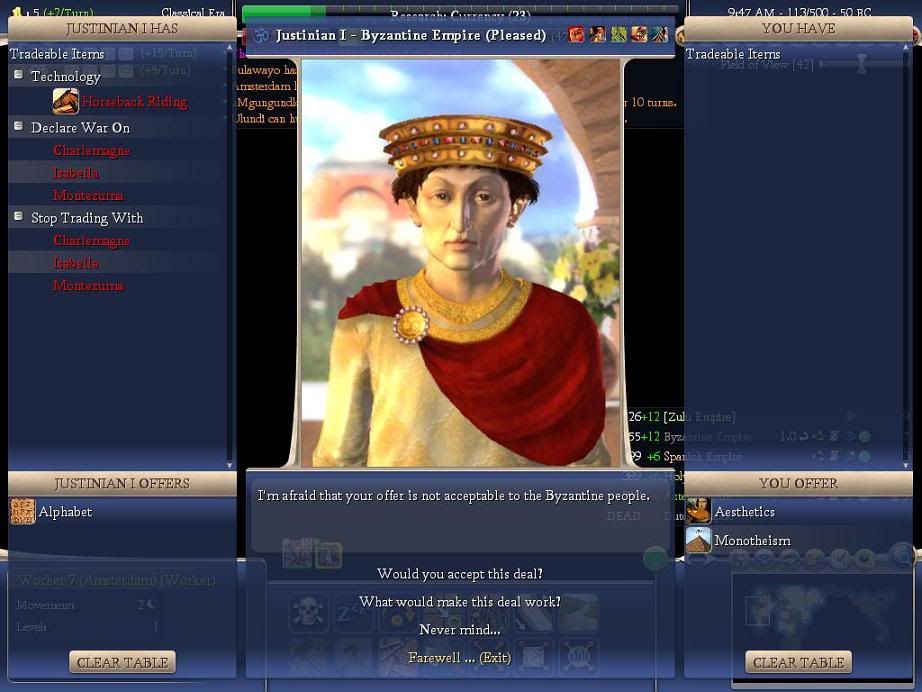 (OH COME ON JUSTIN GIVE A GUY A BREAK. GAH. They parted with NO free techs or monetary gifts this round, either!)
(OH COME ON JUSTIN GIVE A GUY A BREAK. GAH. They parted with NO free techs or monetary gifts this round, either!)
Grumbling at Justinian's arrogance, Shaka turned to the artist-scholars-but-not-really-warriors of Amsterdam. Though he hated to give authority to these milquetoasts, they had served Zululand well since Willem's death. It was agreed: Amsterdam would be the center of Zulu knowledge and scholarship. A Great Library was to be built with the strength of Nongama's marble.
 (As you'll see, that took SIGNIFICANTLY less than 59 turns. Marble went online shortly after this, and Amsterdam had a couple of workers chopping overtime and building mines.)
(As you'll see, that took SIGNIFICANTLY less than 59 turns. Marble went online shortly after this, and Amsterdam had a couple of workers chopping overtime and building mines.)
To commemorate the occasion, Shaka approved the settlement of the village of Nodwengu, which would serve to connect the scholars of the west to the warriors of the east.
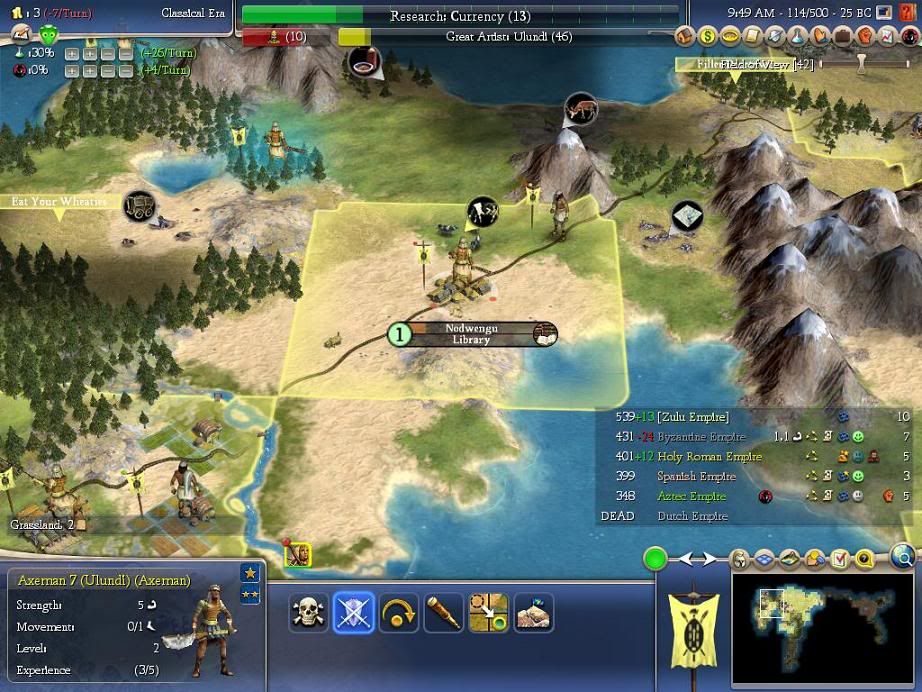 (...okay, that one was probably a mistake at this point. I thought recalling some of the fogbusters into the borders would help more than it did, so I set up Nodwengu to watch the pass. It's a better city now that it's starting to get going, but at the time, it was just another drag.)
(...okay, that one was probably a mistake at this point. I thought recalling some of the fogbusters into the borders would help more than it did, so I set up Nodwengu to watch the pass. It's a better city now that it's starting to get going, but at the time, it was just another drag.)
While the west was civilized, in the east, the hinges threatened to come off of the Zulu Empire. Upkeep was spiraling out of control. Unable to pay for scholarship, Shaka found himself lowering science as a priority in favor of pittances of taxes. Shaka did what he could throughout the empire to increase fiscal output, sacrificing his people's legendary production for commerce and sending some of his city's warrior-miners to work in the empire's Libraries to keep research toward a unified Currency afloat.
Seeing weakness in his warrior brother, Montezuma made his move.

The move infuriated Shaka. He longed to send the fish to Aztec lands escorted by waves and waves of Axemen and Impis. However, war against Montezuma would be fruitless. The war-chief begrudgingly consented to share his surplus, which Pleased the Aztec chief.
(Yeah, whatever, Monty, it's yours. I still need to cancel that deal. Monty doesn't have anything worth trading just yet, though.)
By 275 AD (
Now the calendar counts UPWARD? Shaka roared.), thanks to the efforts of Dutch loggers and marble from the east, the Zulu center of knowledge and learning was complete:
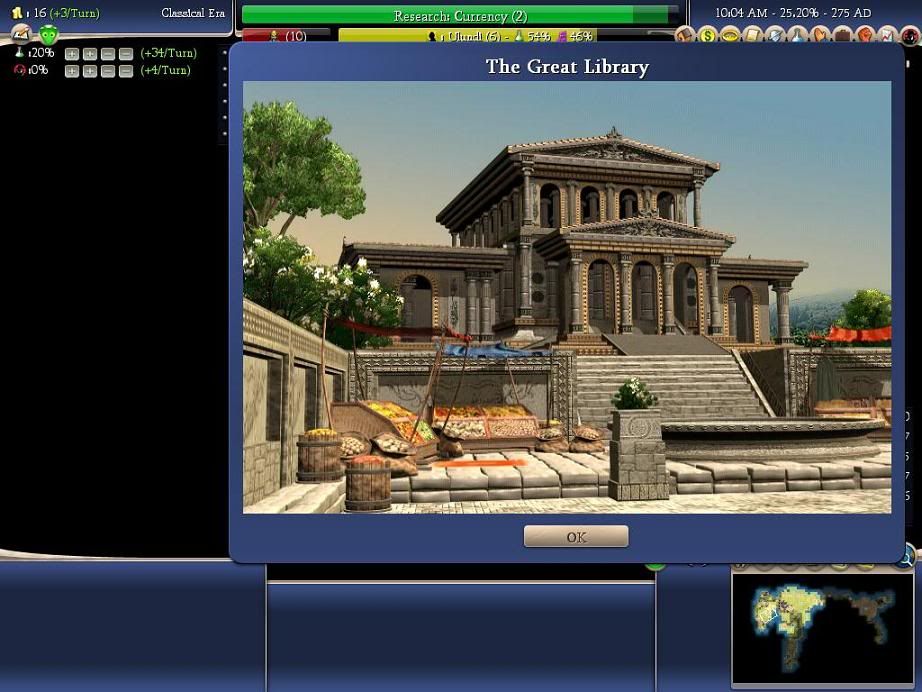
Amsterdam immediately began work on a National Epic to celebrate the occasion and draw more of Zululand's warrior-scientists to the city.
With his Great Library built, Shaka finally felt comfortable sharing the secrets of Literature with his allies in Byzantium (Isabella had completed the technology decades earlier):
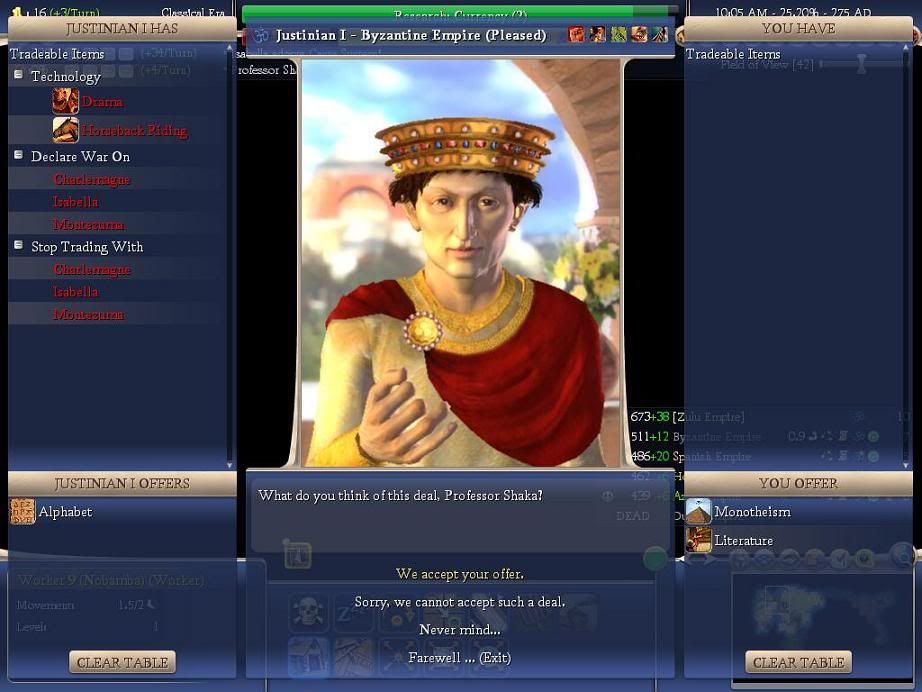 (Highway robbery, but yeah, we're way late getting to Alpha.)
(Highway robbery, but yeah, we're way late getting to Alpha.)
And 25 years later, the long trek was complete.
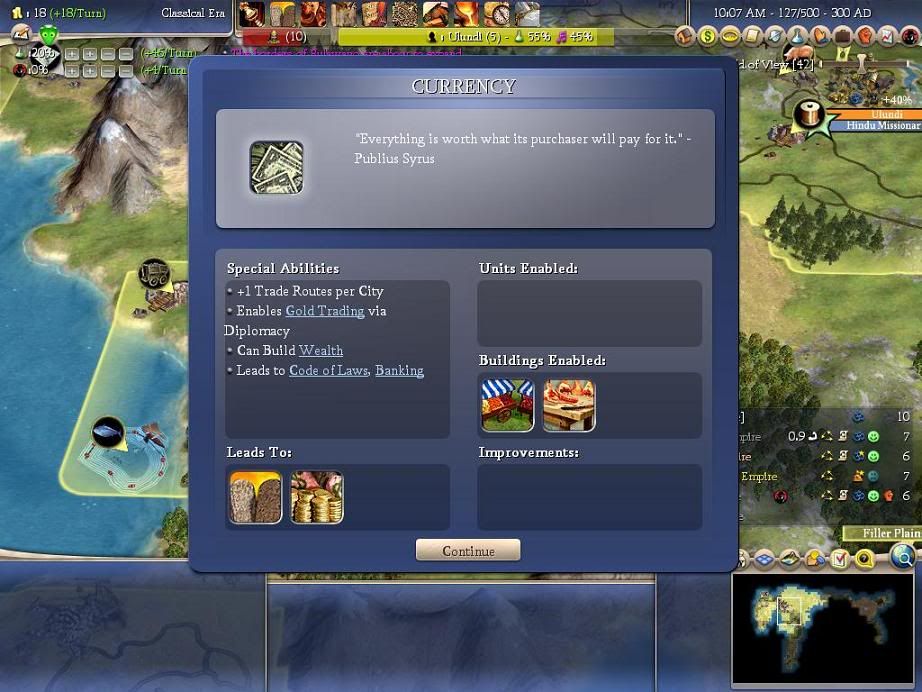 (The trade routes alone gave us about 15 gpt!)
(The trade routes alone gave us about 15 gpt!)
The Zulu economy--previously in shambles--was now on the road to recovery. But at what cost? At... what... cost?
We'll find out shortly!

 ). A GP Farm doesn't need much ( Granary: 60, Library: 90, Great Library: 350 less the marble bonus, National Epic: 250 less the marble bonus).
). A GP Farm doesn't need much ( Granary: 60, Library: 90, Great Library: 350 less the marble bonus, National Epic: 250 less the marble bonus). and +2
and +2  / turn)
/ turn) capital!" If so, then say that.
capital!" If so, then say that.
 Look forward to seeing how you go.
Look forward to seeing how you go. 

















 This certainly makes the filler plains town more of a monster.)
This certainly makes the filler plains town more of a monster.)





